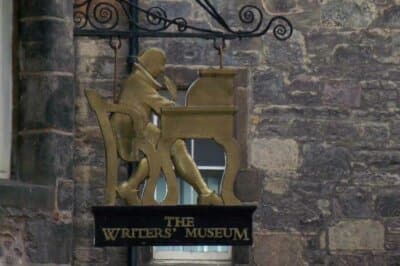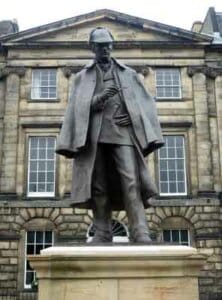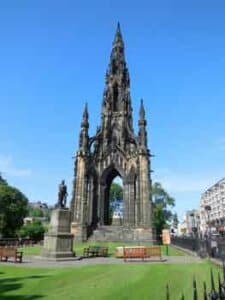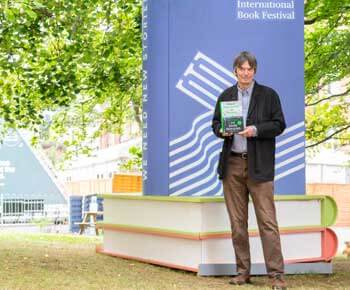
Edinburgh was crowned the first UNESCO City of Literature in 2004.
As a UNESCO City of Literature, Edinburgh is recognised for its significant contributions to world literature. It was crowned the first UNESCO City of Literature in 2004.
The city with its Old Town built around the bulk of Edinburgh Castle and its New Town with its wide streets and stylish Georgian houses was crowned the first UNESCO City of Literature in 2004.
For centuries Edinburgh’s people and historic streets have inspired writers to create world-famous literary works. There are signs of their work in every part of the city.
The list below is a brief introduction to some of the men and women who shaped Edinburgh’s literary heritage.
Daniel Defoe
The Royal Mile is at the centre of the Old Town and stretches from Edinburgh Castle to the Palace of Holyroodhouse.
Daniel Defoe of Robinson Crusoe fame, and a frequent visitor to the city in the early 18th century, said of the Mile, “It was the longest and finest street in the World…”
Robert Louis Stevenson & St Giles’ Cathedral
Close to the castle is St Giles’ Cathedral, a fixture on the Edinburgh landscape for over 900 years. Robert Burns and Robert Louis Stevenson are both commemorated inside.
Outside a heart-shaped mosaic is set in the pavement marking the site of the old tollbooth prison immortalised in Sir Walter Scott’s, The Heart of Midlothian.
Encyclopaedia Britannica
As you head towards the Writers Museum, you pass Anchor Close where the first edition of the Encyclopaedia Britannica came to light and the works of Robert Burns went on to enchant a nation.
edinburgh Writers Museum
Edinburgh’s Writers Museum is housed in Lady Stairs House and has exhibitions dedicated to three of Scotland’s greatest writers: Robert Burns, Sir Walter Scott and Robert Louis Stevenson.
In a nearby cluster are the National Library of Scotland, The Scottish Storytelling Centre and the Scottish Poetry Library.
The Body Snatchers
Robert Louis Stevenson’s macabre; The Body Snatchers was inspired by the notorious Burke and Hare who stalked the Old Town in the 19th century, intent on selling their victim’s bodies for medical research. Some of Burke’s remains are on display at the unique Pathology Museum at Surgeon’s Hall.

Arthur Conan Doyle & Sherlock Holmes
Arthur Conan Doyle who studied medicine in Edinburgh would have been familiar with Surgeon’s Hall.
His famous detective, Sherlock Holmes was based on Joseph Bell, one of his professors. He said to the astute and analytical Bell, “It is most certainly to you that I owe Sherlock Holmes.”
Sir Walter Scott
The 200ft Scott Monument stands in Princes Street Gardens dedicated to the memory of Sir Walter Scott. Those with the energy to climb its 287 stairs are rewarded with a stunning view of the city.
JK Rowling: Harry Potter
Not to be outdone, our contemporary writers have also used the city as a backdrop. It is believed for example that JK Rowling used the Renaissance splendour of George Heriot’s School as the model for Hogwarts, Harry Potter’s school of wizardry.
Irvine Welsh: Trainspotting

Irvine Welsh, an acclaimed yet controversial novelist, has shown the world a grittier side of Edinburgh in his book Trainspotting, much of which was set in Leith.
Alexander McCall Smith: A Work of Beauty
No list of Edinburgh Writers would be complete without Alexander McCall Smith.
His wonderful book, A Work of Beauty is his own story of Edinburgh.
While the book is packed with information about a city he knows well, this wonderful quotation from it sums it up “Edinburgh is a city of fragile beauty, of secretive corners and sudden vistas.”
Let’s not forget:
- Ian Rankin: Inspector Rebus
- Muriel Spark: The Prime of Miss Jean Brodie so often associated with the Grassmarket
Edinburgh International Book Festival
Usually held in August, the Edinburgh International Book Festival is held ( at the time of writing) in the beautiful Charlotte Square Gardens in Edinburgh’s New Town.
The festival regularly attracts the cream of British and international writing.

Edinburgh Festivals says, “The largest collection of the written word in the world brings entertainment and inspiration to Edinburgh.”
Go to the Edinburgh International Book Festival website for more information.
Unsurprisingly given Edinburgh’s literary heritage, Scotland’s capital city is packed with independent bookshops. They are such a joy to explore.
As visitors to Scotland’s capital city return home, they may reflect on their experiences in this historic city, where everywhere lie reminders that literary giants have passed this way.